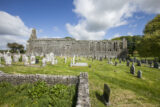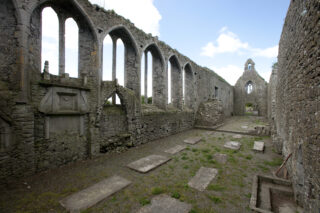Lorrha Dominican Priory
A priory situated in a village with a long connection to Christianity
Unguided sitesFógra
WARNING: It should be noted that these sites are unguided and a level of care and caution should be maintained during all stages of your visit. The Office Of Public Works (OPW) will not be held responsible for any damages, injuries, or losses that occur
Lorrha Dominican Priory
Lorrha is located west of Birr and about 5 kilometres from the river Shannon and the border between counties Tipperary and Galway. The village has a long connection with Christianity in Ireland and was the site of an early monastery associated with St. Ruadhán, who was active in the 6th century. A Dominican Priory, dedicated to St. Peter of Verona, was founded in Lorrha in 1269 by Walter de Burgo, the Earl of Ulster. St. Peter was a Dominican monk and preacher assassinated in 1252 and subsequently canonised in March 1253. The Priory was dissolved in the mid-16th century, but the Dominicans appear to return to the site in the 17th century. In 1812 the current Roman Catholic Church, St. Ruadhán’s, was built on the grounds of the priory just to the north of the surviving ruins. In 1939 the west wall and gable of the medieval structure collapsed and this wall, doorway, window and bellcote were subsequently reconstructed by the OPW.
The remaining ruins of the Priory stand at the south-western end of the village, forming a rectangular structure approximately 50 metres in length. From the roadside the most striking features are the six closely spaced pairs of lancet windows in the south wall of the chancel. Within the chancel a number of architectural church features survive including an aumbry, which was a cupboard in the wall, in this case containing a credenza and double piscina. The piscina is a shallow basin, usually with a drain leading directly to the earth underneath. It was used to wash the communion vessels after use and the double piscina allowed the hands to be washed in the second basin. The credenza is a shelf the communion vessels could be placed on for storage when not in use.
A number of tombstones and memorials rest within the bounds of the priory ruins. A 17th century altar tomb commemorates the O’Kennedy family and is dated to 1629. A wall plaque also is also connected with the O’Kennedy family and shows their coat of arms along with the Latin motto “Spes mea in Deo” or “My hope is in God”. Another wall plaque, dated to 1689, commemorates Constantine Egan and his son John and depicts the Egan coat of arms.
Three medieval stone carvings, originally from the priory, are now displayed on the east gable of the nearby Roman Catholic Church. The first depicts a man’s head with closely cropped hair, the second shows a winged angel and the third is a man’s head with long flowing hair. It is likely other architectural fragments from the medieval structure are hidden within the fabric of the walls of this later building.
Visit Historic Environment Viewer for more information on Lorrha Dominican Priory
Protect our Past - Click here to read about the importance of protecting our country’s unique heritage sites
This national monument is protected in accordance with the National Monuments Acts 1930 to 2014
Gailearaí
Suíomhanna cóngarach
Caisleán agus Gairdíní Phort Omna
Breáthacht ón seachtú haois déag ar bhruacha Loch Deirgeirt
Timpeall 6.3 km ón
Caisleán agus Gairdíní Ros Cré, agus Teach Damer/ Muilte Dubha
Áit a léiríonn cumhacht mheánaoiseach agus galántacht ón ochtú haois déag
Timpeall 26.6 km ón
Láithreán Mainistreach Chluain Mhic Nóis
Mainistir shuntasach ar bhruach abhainn na Sionainne
Timpeall 27.8 km ón




